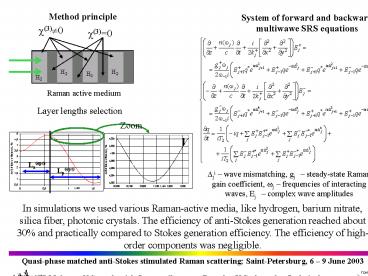System of forward and backward multiwawe SRS equations - PowerPoint PPT Presentation
1 / 9
Title:
System of forward and backward multiwawe SRS equations
Description:
Quasi-phase matched anti-Stokes stimulated Raman scattering; Saint-Petersburg, 6 9 June 2003 ... stimulated Raman scattering; Saint-Petersburg, 6 9 June ... – PowerPoint PPT presentation
Number of Views:64
Avg rating:3.0/5.0
Title: System of forward and backward multiwawe SRS equations
1
System of forward and backward multiwawe SRS
equations
?ji wave mismatching, gj steady-state Raman
gain coefficient, ?j frequencies of interacting
waves, Ej complex wave amplitudes
In simulations we used various Raman-active
media, like hydrogen, barium nitrate, silica
fiber, photonic crystals. The efficiency of
anti-Stokes generation reached about 30 and
practically compared to Stokes generation
efficiency. The efficiency of high-order
components was negligible.
2
Principle of quasi-phase matching at SRS
- Generalized phase on active layers input do not
practically change, that in a final result
provides a realization of quasi-phase matching
conditions
3
Raman gain dispersion
Barium nitrate
Hydrogen
4
Backward SRS vs. QPM realization
High SRS components vs. calc. precision
5
Influence of input waves parameters on
anti-Stokes generation efficiency
6
The influence of pump wavelength on anti-Stokes
generation efficiency
7
The effective generation of anti-stokes radiation
in one dimensional photonic crystals
?11, ?213, l1175.0000 nm, l2287.8774 nm ?
?0.263 rad/cm eff_a30.1 ?11, ?213,
l1175.037 nm, l2287.870 nm ? ?0.004 rad/cm
eff_a29.8
Effective wave vector in one-dimension photonic
crystal
8
Conclusions
- Our model of forward and backward multiwave SRS
is the extension of multiwave SRS model and it
may be reduced to well-known systems of forward
multiwave SRS and backward SRS - For best accuracy of QPM SRS simulations it is
necessary to take into account the dispersion of
Raman gain coefficient - The influence of backward SRS on QPM structure
realization results in the small difference
between layers length of optimal QPM structure
and small decreasing of resulting anti-Stokes
conversion efficiency (25 at backward and
forward SRS, 30 at forward SRS), however it is
still high enough - For studying of multiwave SRS influence on QPM
structure realization it is necessary to take
into account the generation at least of 3 Stokes
and 3 anti-Stokes SRS components - The effective anti-Stokes SRS generation occurs
in a wide range of input radiation parameters - It is possible to use one-dimension photonic
crystals for high effective (up to 30)
anti-Stokes SRS generation
9
References
- Armstrong J.A., Bloembergen N., Ducuing J.,
Pershan P.S. // Phys. Rev., 1962, 127, pp.
1918-1939. - Bespalov V.G., Makarov N.S. Quasi-phase matching
generation of blue coherent radiation at
stimulated Raman scattering // Optics
Communications 2002, 203 (3-6), pp. 413-420. - Maier M., Kaiser W., Giordmaine J.A. Backward
stimulated Raman scattering // Phys. Rev., 1969,
V. 177, ?2, pp. 580-599. - Raijun Chu, Morton Kanefsky, Joel Falk Numerical
study of transient stimulated Brillouin
scattering // J. Appl. Phys., 1992, V. 71, ?10,
pp. 4653-4658. - Zaporozhchenko R.G., Kilin S.Ya, Bespalov V.G.,
Staselko D.I. Formation of the spectra of
backward stimulated Raman scattering from the
quantum noise of polarization of a scattering
medium // Opt.Spectr., 1999, V. 86, ?4, pp.
632-639. - Bischel W.K., Dyer M.J. Wavelength dependence of
the absolute Raman gain coefficient for the Q(1)
transmission in H2 // J. Opt. Soc. Am. B, 1985,
V. 3, pp. 677-682. - Nefedov I.S., Tretyakov S.A. Photonic band gap
structure containing metamaterial with negative
permittivity and permeability // Phys. Rev. E,
66, 2002, p. 036611.































